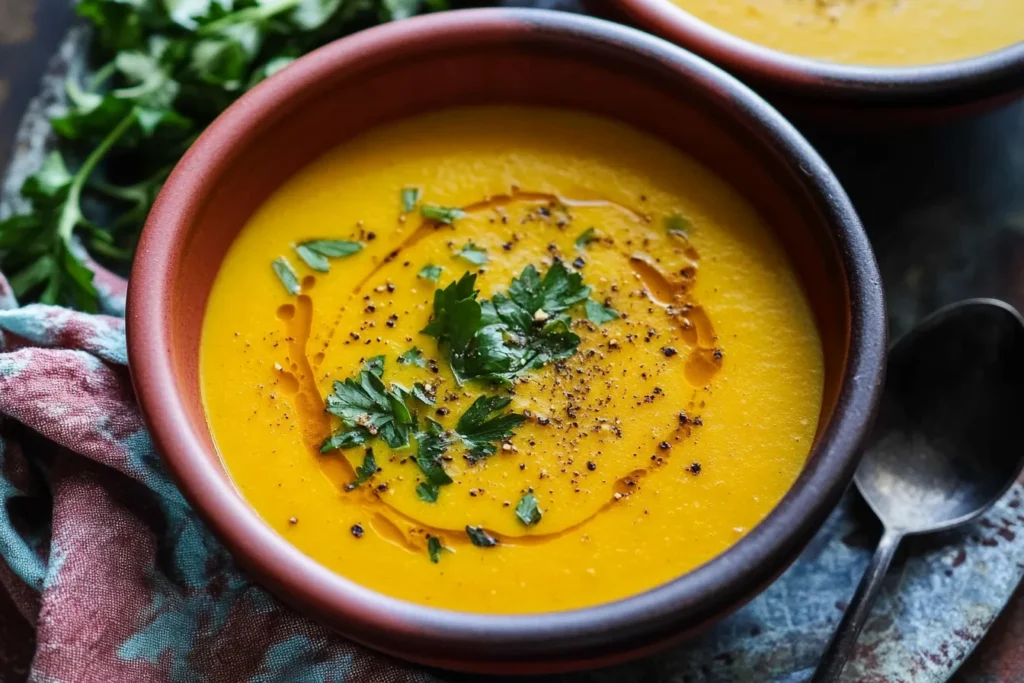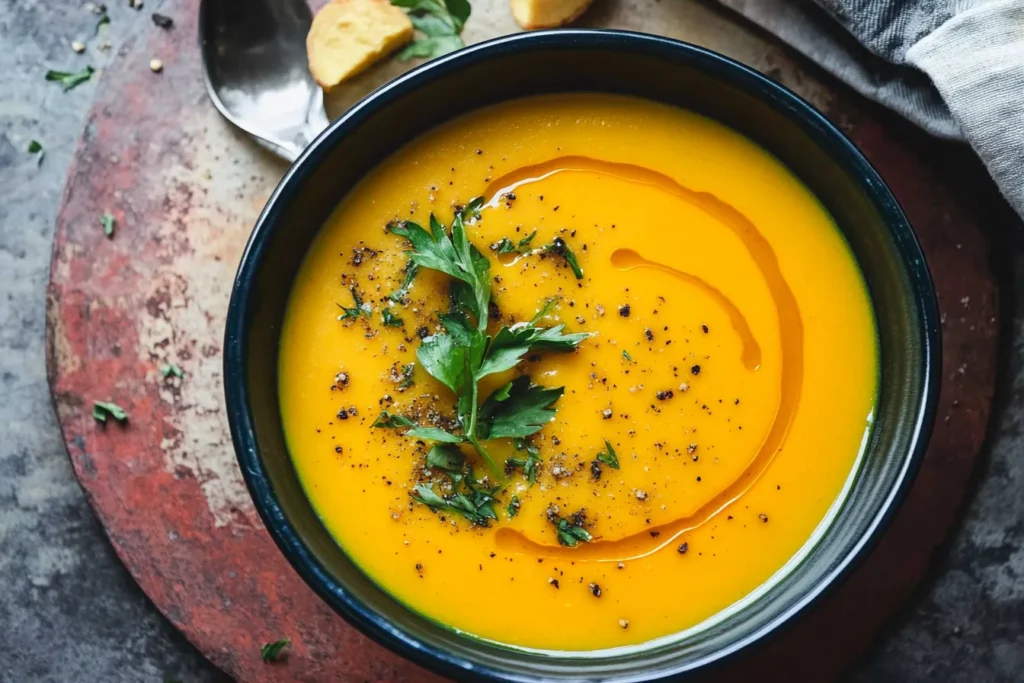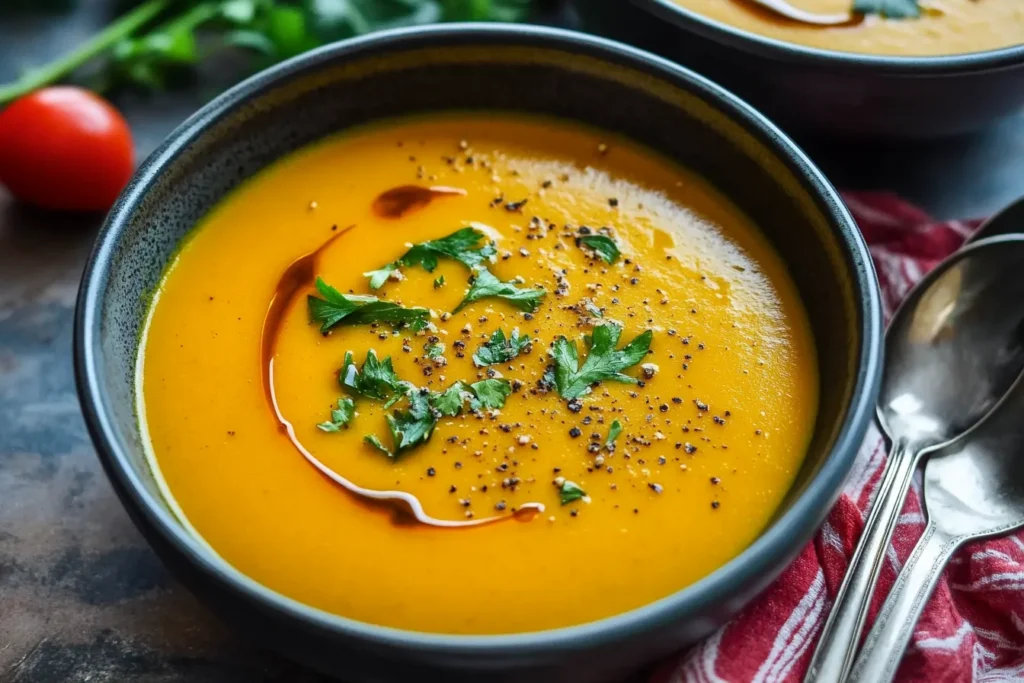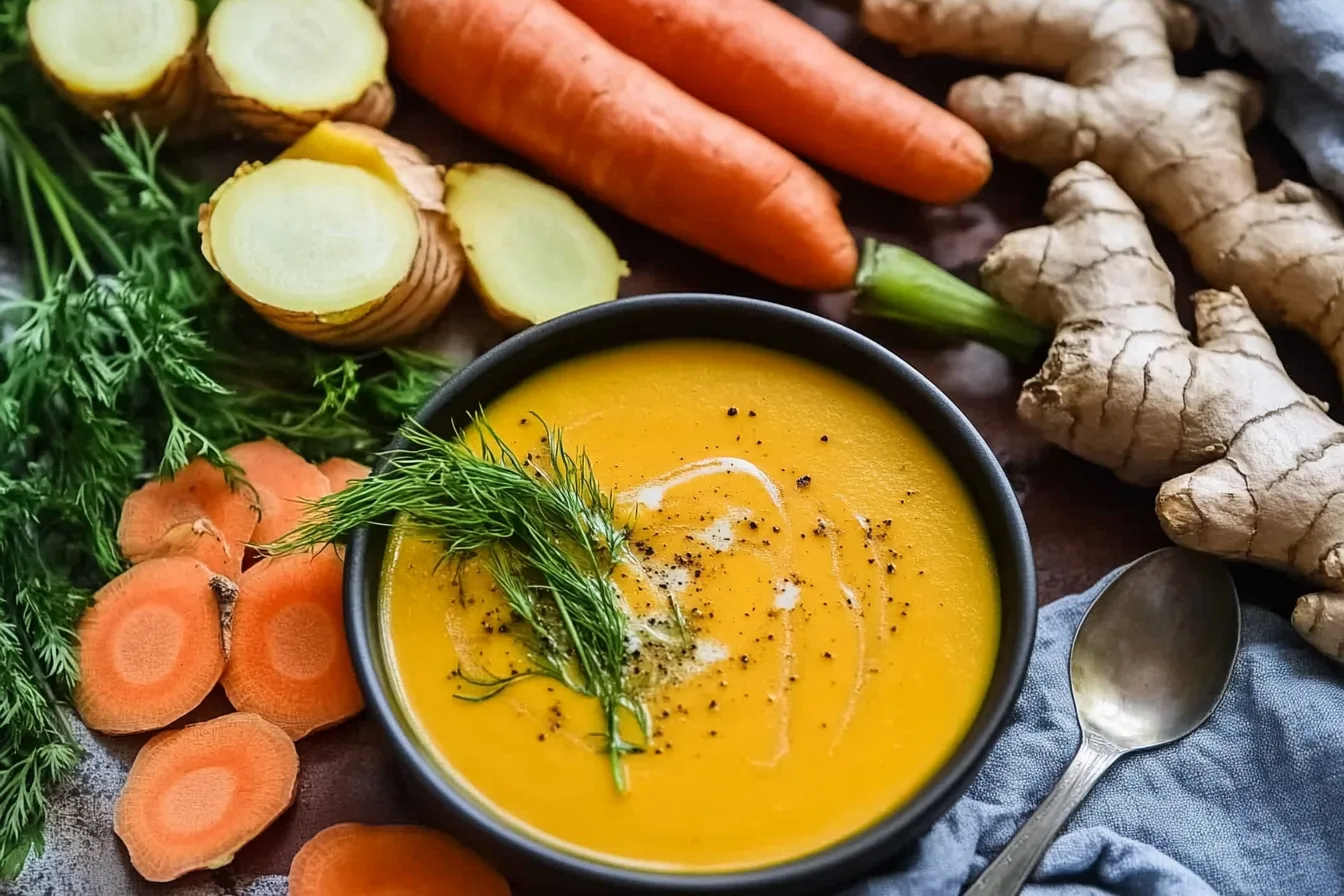Ginger Turmeric Soup isn’t just a comforting bowl of warmth—it’s a therapeutic, nutrient-rich elixir that’s fast becoming a favorite among health-conscious home cooks and professional chefs alike.
At its core, this golden-hued soup is made with two of the most potent healing spices known to traditional medicine: ginger and turmeric. These roots are celebrated not only for their rich flavor but also for their long-standing medicinal value in Ayurveda, Traditional Chinese Medicine (TCM), and Western naturopathy.
Whether you’re fighting off a cold, recovering from an intense workout, or simply trying to support your immune system, ginger turmeric soup delivers both flavor and function in every spoonful.

Culinary and Medicinal Background
- Ginger, known for its zesty heat and anti-nausea effects, has been used for millennia across Asia to support digestion, relieve pain, and ease respiratory issues.
- Turmeric, with its earthy, slightly bitter profile, brings a vibrant color and the renowned compound curcumin, noted for its anti-inflammatory properties.
- When these two are combined in a warm, hearty soup, the result is a balanced, anti-inflammatory meal that supports health and digestion.
Why It’s a Trending Wellness Dish
With the surge in anti-inflammatory diets and immunity-boosting recipes, ginger turmeric soup has found its way into:
- Meal prep rotations
- Wellness cleanses
- Restaurant menus
- Cold and flu remedies
Its flexibility, healing potential, and soothing properties make it not just a trend, but a culinary staple for longevity.
Health Benefits of Ginger and Turmeric in Soup
Ginger and turmeric are functional ingredients—that is, foods that serve a medicinal purpose. When included in soup form, they become easy to digest and pair beautifully with other nutrient-dense ingredients like garlic, lemon, bone broth, and leafy greens.
Anti-Inflammatory Effects
- Curcumin in turmeric and gingerol in ginger both target inflammatory pathways in the body.
- These compounds help reduce swelling and pain, especially in joints and muscles.
- Useful for people managing arthritis, autoimmune conditions, or exercise-induced inflammation.
Immunity Boosting
- Ginger boosts circulation and sweating, which may help detoxify the body during illness.
- Turmeric supports the immune system through its antioxidant activity and ability to regulate immune cell function.
- When paired with ingredients like garlic (antiviral) and lemon (vitamin C), this soup becomes a powerhouse against seasonal viruses.
Digestive and Detoxifying Benefits
- Ginger enhances digestion by stimulating digestive enzymes and bile flow.
- Turmeric supports liver detoxification and reduces bloating.
- A warm soup made with these roots soothes the stomach and is often used in gut-healing diets.
The Science Behind Ginger and Turmeric
Modern research continues to back what traditional cultures have known for centuries: these spices work on a cellular level to reduce disease and promote health.

Curcumin and Its Healing Properties
- Curcumin, the active compound in turmeric, has been studied for its ability to:
- Fight oxidative stress
- Lower inflammation markers
- Support cognitive function
- Reduce the risk of chronic disease
However, curcumin is poorly absorbed on its own, which is why soup recipes often include black pepper (piperine) or fats to increase bioavailability.
Gingerol’s Role in Inflammation Relief
- Gingerol, the compound that gives ginger its spicy kick, has analgesic and anti-inflammatory properties.
- It’s especially effective for managing soreness, cramps, and gastrointestinal discomfort.
- Research has shown that gingerol can even modulate pain perception by acting on certain nerve channels.
Synergistic Effects When Combined
When ginger and turmeric are consumed together, their effects are amplified:
- Their combined antioxidant power fights free radicals more effectively.
- They both support detox pathways, especially in the liver and gut.
- The dual action on inflammation helps create a balanced internal environment, improving energy, clarity, and resilience.
Why Add Lemon, Garlic, and Other Boosters
While ginger and turmeric form the foundation, flavor and therapeutic value deepen when other ingredients are added.

Antioxidants in Garlic
- Garlic contains allicin, a compound known for antibacterial, antiviral, and antifungal properties.
- When crushed and added to soup, garlic boosts immune protection and supports heart health.
Vitamin C from Lemon
- Lemon brightens the soup’s flavor while providing a boost of vitamin C, essential for collagen production and immunity.
- It also helps create a more alkaline environment, which some believe supports detox.
Enhancing Taste and Health
- Black pepper improves turmeric absorption.
- Coconut milk provides healthy fat for nutrient absorption and a creamy texture.
- Greens like kale or spinach add fiber, minerals, and a bitter contrast to the warmth of the spices.
These add-ins not only enhance taste but also optimize the body’s response to the healing spices.
Nutritional Profile of Ginger Turmeric Soup
Ginger turmeric soup can be as light or hearty as you want, depending on the base and additions. Its core ingredients are naturally low in calories but rich in nutrients.
Calories, Fiber, Vitamins, and Minerals
- A basic bowl with broth, ginger, turmeric, and lemon is usually under 150 calories.
- Adding lentils, coconut milk, or chicken can bring it up to 300–400 nutrient-rich calories.
- High in vitamin C, potassium, manganese, and iron when combined with leafy greens and legumes.
Macronutrient Balance
- Can be balanced with protein from lentils or chicken, healthy fats from coconut milk or olive oil, and complex carbs from root vegetables or grains.
- Suitable for low-carb, paleo, gluten-free, and vegan diets depending on the ingredients chosen.
Protein Content with Lentils or Chicken
- Red lentils add 12–15g of protein per serving.
- Chicken or bone broth enhances the bioavailability of amino acids and adds depth of flavor.
- Combined with spices, it becomes a high-protein, low-inflammatory meal ideal for recovery.
Best Times to Eat Ginger Turmeric Soup
This soup is as flexible in timing as it is in ingredients.
As a Flu-Fighting Winter Meal
- Warm, spicy, and hydrating—perfect when you’re under the weather.
- Helps with nasal congestion, sore throat, and body aches.
Ideal Post-Workout Recovery Food
- Reduces inflammation and muscle soreness.
- Replenishes fluids and electrolytes when made with broth and vegetables.
Light Dinner for Digestion
- Easy on the stomach and promotes better sleep.
- Helps wind down the digestive system with its warming, soothing properties.
Ginger Turmeric Soup and Gut Health
Gut health is a cornerstone of wellness, and this soup supports it on multiple levels.
How It Supports Microbiome Balance
- Ginger and turmeric have antimicrobial properties that regulate harmful bacteria.
- When combined with prebiotic-rich vegetables like leeks or onions, they nourish beneficial microbes.
Soothing Properties for Bloating
- Ginger relieves gas and bloating by relaxing intestinal muscles.
- Turmeric reduces gut inflammation and supports intestinal barrier health.
Prebiotic and Anti-Microbial Effects
- Garlic and onions serve as prebiotics.
- Broths and spices reduce microbial imbalance and encourage healing of the gut lining.
Can Ginger Turmeric Soup Help with Weight Loss?
This soup is a go-to for those focusing on fat loss without sacrificing nourishment.
Appetite Suppression
- Ginger may enhance satiety by affecting serotonin levels.
- Warm, spiced soups reduce the urge for snacking.
Thermogenic Ingredients
- Ginger and turmeric both have thermogenic properties, which can slightly increase calorie burn.
- When paired with spicy elements like cayenne or black pepper, the effect is stronger.
Low-Calorie, Nutrient-Dense Makeup
- You get a lot of nutrients per calorie with this soup.
- It can easily be used for intermittent fasting windows or detox plans.
Potential Side Effects and Who Should Avoid It
Although it’s generally safe, some people should consume ginger turmeric soup with caution.
Ginger/Turmeric Sensitivity
- May cause heartburn or stomach discomfort in some individuals.
- Start with smaller quantities if you’re new to these spices.
Medication Interactions
- Turmeric can interfere with blood thinners.
- Ginger may affect blood sugar or blood pressure medications.
- Always consult your doctor if you’re managing a condition.
Pregnancy Considerations
- Moderate amounts are usually safe, but high doses of turmeric should be avoided.
- Use fresh ingredients and avoid concentrated powders or extracts during pregnancy.
Ginger Turmeric Soup Across Cultures
This soup has global appeal with distinct regional influences.
Indian Golden Soup Varieties
- Often made with dal (lentils), turmeric, garlic, and ghee.
- Served with rice or flatbread as a healing, everyday meal.
Thai Turmeric Coconut Soups
- Combines turmeric with lemongrass, lime, and chili.
- Coconut milk adds a rich and creamy base.
Western Interpretations and Healing Broths
- Use bone broth or vegetable stock, garlic, and herbs.
- Often featured in cleanse diets, gut-healing programs, and detox plans.
Recipes & Ingredient Variation
Basic Ginger Turmeric Soup Recipe
Before exploring variations, let’s start with the foundational recipe. This basic ginger turmeric soup is simple, warming, and packed with anti-inflammatory ingredients—perfect as a starting point or standalone wellness meal.
Core Ingredients:
- 1 tablespoon olive oil or coconut oil
- 1 medium onion, diced
- 2 cloves garlic, minced
- 1 tablespoon fresh ginger, grated (or 1 tsp ground)
- 1 tablespoon fresh turmeric, grated (or 1 tsp ground)
- 4 cups vegetable or chicken broth
- Juice of 1 lemon
- Salt and pepper to taste
Cooking Instructions:
- Heat oil in a large pot over medium heat.
- Sauté onion until translucent, then add garlic, ginger, and turmeric.
- Stir for 1–2 minutes until fragrant.
- Pour in broth, bring to a boil, then reduce to simmer for 15–20 minutes.
- Add lemon juice, season to taste, and serve warm.
Preparation Time:
- Prep: 10 minutes
- Cook: 20 minutes
- Total: 30 minutes
Vegan Ginger Turmeric Lentil Soup
This variation is ideal for those looking for a plant-based, protein-rich, and fiber-packed meal.
Using Red Lentils or Split Peas
- Red lentils cook quickly and dissolve into a creamy texture.
- Split peas add heartiness and bulk—great for a more rustic consistency.
Coconut Milk or Broth Base
- For richness, use full-fat coconut milk.
- For a lighter soup, stick to vegetable broth or a combo.
Ideal Spices and Herbs
- Add cumin, coriander, and a dash of chili flakes for warmth.
- Finish with cilantro, parsley, or a squeeze of lime.
Tip: Simmer gently for 25–30 minutes, or until lentils are soft.
Ginger Turmeric Chicken Soup
For a hearty, protein-rich version, chicken pairs perfectly with these anti-inflammatory spices.
Bone Broth or Stock Base
- Bone broth adds collagen, amino acids, and rich flavor.
- A good alternative: homemade chicken stock.
Shredded Chicken Additions
- Use pre-cooked or rotisserie chicken to save time.
- Add during the last 10 minutes to retain moisture.
Anti-Inflammatory Protein-Rich Meal
- Combine with carrots, celery, and greens like spinach or kale.
- Add quinoa or brown rice for more substance.
Tip: This version is excellent for recovery or post-flu nourishment.
Creamy Turmeric Carrot Ginger Soup
This blended variation is perfect for when you crave a silky, smooth texture with subtle sweetness.
Roasted or Sautéed Carrots
- Roasting intensifies the carrots’ flavor.
- Sautéing saves time but offers a lighter taste.
Blending for Silky Texture
- Use an immersion blender or high-speed blender.
- Add broth slowly for desired consistency.
Dairy-Free Creamy Options
- Coconut milk creates a rich, luxurious feel.
- Cashew cream adds a nutty undertone and thickness.
Flavor boost: Add a sprinkle of cinnamon or smoked paprika.
Turmeric Coconut Ginger Soup
Inspired by Thai and Southeast Asian cuisine, this soup combines spice, creaminess, and citrusy freshness.
Thai-Inspired Flavors
- Includes lemongrass, galangal (or extra ginger), and lime leaves.
- Lightly spicy and deeply aromatic.
Using Lemongrass and Lime
- Bruise lemongrass stalks to release flavor.
- Finish with fresh lime juice and zest for brightness.
Balancing Richness and Spice
- Use light coconut milk for a healthier twist.
- Add chili oil or sambal for heat lovers.
Garnish with Thai basil, bean sprouts, or chili flakes for authenticity.
Detox Ginger Turmeric Vegetable Soup
Light, nourishing, and packed with colorful vegetables, this soup is perfect for a reset or cleanse.
Low-Calorie Broth Base
- Use water or homemade vegetable broth for minimal sodium.
- Add a splash of apple cider vinegar to aid digestion.
Best Vegetables for Cleansing
- Zucchini, spinach, celery, cabbage, leeks, and carrots.
- Avoid starchy vegetables like potatoes for a lighter feel.
Light, Energizing, and Hydrating
- Contains natural electrolytes.
- Keeps you full with fiber and minerals.
Best enjoyed warm with a drizzle of lemon juice.
Slow Cooker Ginger Turmeric Soup Recipe
Meal prep made easy—this version requires minimal effort and maximum flavor.
Prep Tips for Crockpot Cooking
- Sauté aromatics first for richer flavor, or add everything raw.
- Layer root vegetables on the bottom to ensure even cooking.
Flavor Development Over Time
- Slow cooking allows spices to mellow and integrate deeply.
- Let it cook on low for 6–8 hours or high for 3–4 hours.
Storage and Batch Cooking Ideas
- Freeze individual portions in silicone molds or glass jars.
- Perfect for grab-and-go lunches.
Works great with lentils, chickpeas, or barley.
Spicy Ginger Turmeric Soup with Chili
Turn up the heat for an extra metabolism-boosting twist.
Boosting Heat for Metabolism
- Ginger and chili increase thermogenesis, slightly raising calorie burn.
- Ideal for winter or cold symptoms.
Pepper, Cayenne, or Jalapeño Options
- Black pepper enhances turmeric’s curcumin.
- Cayenne adds fast heat.
- Fresh jalapeño delivers bold spice and flavor.
Balancing Spice with Coconut or Yogurt
- Cool it down with a dollop of yogurt or swirl in coconut milk.
- Garnish with avocado slices or lemon juice to mellow the spice.
How to Add Grains: Quinoa, Rice, or Barley
Grains add texture, satiety, and nutritional depth to your soup.
Texture and Nutritional Boost
- Quinoa: High in protein and cooks fast.
- Brown rice: Chewy, hearty, and fiber-rich.
- Barley: Nutty and great for cold-weather versions.
Cooking Time Adjustments
- Pre-cook grains or add early in the simmer process.
- Be mindful of absorption—you may need extra broth.
Best Pairings for Ginger-Turmeric Flavor
- Earthy grains complement the spices.
- Combine with leafy greens or roasted root veggies.
Garnishing and Serving Suggestions
A soup is only complete with the right toppings and sides.
Fresh Herbs: Cilantro, Parsley, Basil
- Add freshness and aroma.
- Chop just before serving for best flavor.
Yogurt Swirls or Chili Oil Drizzles
- Greek yogurt or coconut cream adds cool richness.
- Chili oil adds spice and color contrast.
Crusty Bread, Rice Crackers, or Naan
- Serve with a crunchy side for balance.
- Toasted pita or gluten-free crackers also work well.
Finish with a squeeze of lemon or lime to brighten the dish.
Excellent! Let’s now continue with Part 3: Tips, Storage, FAQs & Conclusion of the Ginger Turmeric Soup article.
Tips, Storage, FAQs & Conclusio
Tips for Making the Perfect Ginger Turmeric Soup
Even the best ingredients can underperform without the right technique. Making the perfect ginger turmeric soup is about more than just combining spices—it’s about layering flavors, avoiding bitterness, and bringing out the best in your ingredients.
Balancing Flavors
- Ginger and turmeric are strong, so balance them with aromatics like onion, garlic, and celery.
- Add a touch of acidity (lemon or vinegar) to brighten the overall taste.
- For sweetness, use carrots, sweet potato, or coconut milk to round out any harshness.
Avoiding Bitterness from Turmeric
- Don’t overuse turmeric. 1 tsp per pot is often enough.
- Toasting turmeric lightly in oil for 30 seconds mellows its bitterness.
- Add turmeric early in the cooking process so it can integrate properly.
Layering Ingredients for Depth
- Start with a sauté of onions and garlic, then add ginger and turmeric.
- Add herbs and grains mid-cook.
- Stir in lemon juice, greens, or coconut milk just before serving to preserve freshness.
Tip: Taste as you go, adjusting salt and acid levels for a vibrant, balanced finish.
How to Boost Absorption of Turmeric in Soup
Turmeric’s superstar compound curcumin is powerful but difficult for the body to absorb on its own. With a few tweaks, you can unlock its full healing potential.
Adding Black Pepper for Curcumin Uptake
- Black pepper contains piperine, which can increase curcumin absorption by up to 2,000%.
- Just a pinch per serving is enough.
Including Healthy Fats
- Curcumin is fat-soluble, so it needs fat to be absorbed.
- Add olive oil, ghee, coconut milk, or avocado.
- Let the soup simmer gently to help emulsify and activate the compounds.
Cooking Tips to Preserve Potency
- Avoid high heat, which can break down sensitive compounds.
- Add turmeric at the sauté stage, not boiling point.
- Avoid long boils or overcooking; low and slow is best for flavor and health.
How to Store and Reheat Ginger Turmeric Soup
This soup lends itself beautifully to batch cooking and meal prep—but only if stored correctly.
Refrigeration and Freezing Tips
- Store in glass jars, mason jars, or BPA-free containers.
- Refrigerate for up to 4 days.
- Freeze for up to 3 months; label each container with the date.
Freeze in 1- to 2-cup portions for easy reheating.
Portioning for Meal Prep
- Use silicone soup cubes or freezer bags for compact storage.
- Portion into containers with protein or grains already added, or store separately.
Best Practices to Maintain Flavor
- Reheat on the stovetop, not microwave, to maintain taste and texture.
- Stir well to re-integrate spices and ingredients.
- Add a splash of water or broth if it’s too thick after storage.
Making Soup in Batches for Meal Prep
If you want to save time and eat healthier, batch-cooking ginger turmeric soup is the way to go.
Planning Weekly Soup Meals
- Choose 1–2 base recipes (like lentil or vegetable) and modify toppings or garnishes throughout the week.
- Make a double or triple batch and store half in the freezer.
Storing in Jars or Containers
- Use quart-sized mason jars for family servings.
- Glass lock containers are great for reheating and packing for work lunches.
Rotating Variations to Prevent Boredom
- Start with the same base and vary:
- Grains (quinoa, barley)
- Proteins (tofu, chickpeas, chicken)
- Spices (swap ginger for curry, or add coriander)
- Keeps things fresh without extra effort.
Low-Sodium and Heart-Healthy Adaptations
You can easily make this soup suitable for heart health or sodium-sensitive diets without sacrificing flavor.
Using Homemade Broth
- Homemade vegetable or chicken broth is lower in sodium and richer in nutrients.
- Add seaweed or mushrooms for umami without salt.
Herbs Over Salt for Flavor
- Use thyme, rosemary, basil, oregano, and lemon zest to enhance flavor naturally.
- Add acid (like vinegar or citrus) to replace the “bite” of salt.
Cardiovascular Health Benefits
- Ginger and turmeric reduce inflammation in blood vessels.
- Garlic lowers blood pressure and cholesterol.
- Leafy greens and legumes improve fiber intake, which supports heart health.
Using Soup as a Natural Cold Remedy
Ginger turmeric soup is one of the most effective natural remedies for colds and flu—backed by tradition and science.
Soothing Sore Throats
- The warmth, garlic, and ginger soothe irritated throats.
- Add a teaspoon of raw honey for extra relief and antimicrobial power (once soup is slightly cooled).
Clearing Sinuses
- Spices like cayenne and black pepper open nasal passages.
- The steam from the soup can help relieve congestion.
Hydration and Nutrient Replenishment
- Broth-based soups help replace electrolytes and fluids lost from illness.
- Add leafy greens and citrus for a vitamin boost.
Best Ginger Turmeric Soup for Kids
Even picky eaters can enjoy a version of this soup—with the right tweaks.
Mild and Creamy Versions
- Blend the soup for a smooth texture.
- Use coconut milk for creaminess and natural sweetness.
- Reduce spice quantities—no black pepper or chili.
Sneaking in Veggies
- Puree carrots, zucchini, or sweet potatoes.
- Blend lentils and vegetables together for texture-free nutrition.
Fun Toppings and Presentation
- Serve with croutons, star-shaped carrots, or swirled yogurt.
- Use colorful bowls and let kids help with garnishing.
Buying vs. Making: Store-Bought Soup Options
When time is short, store-bought soups can be a decent alternative—if you know what to look for.
What to Look for in Ready-Made Soups
- Short ingredient list
- Real ginger and turmeric listed up top
- No artificial flavors or preservatives
Label Tips: Preservatives, Sodium, Real Turmeric
- Aim for less than 500mg sodium per serving.
- Avoid “turmeric flavor”—look for actual root or powder.
- Choose BPA-free packaging.
Best Brands and Reviews
- Pacific Foods: Organic, low-sodium turmeric broth
- Daily Harvest: Frozen soup cups with ginger turmeric blends
- Kettle & Fire: Bone broth-based turmeric ginger soups
- Read user reviews for taste and consistency feedback.
Frequently Asked Questions (FAQs)
1. Can you eat ginger turmeric soup daily?
Yes—if balanced, it can be part of a daily diet. Just rotate ingredients to avoid flavor fatigue.
2. Can I add protein powders or supplements?
Absolutely. Collagen powder, hemp seeds, or pea protein can be blended in once the soup cools slightly.
3. Is it safe for pregnant women?
In moderation, yes. Avoid high doses of turmeric or concentrated extracts. Use fresh, whole ingredients.
4. Can I make it oil-free?
Yes. Use water to sauté aromatics and add avocado or coconut milk later for fat-based absorption.
5. How do I thicken ginger turmeric soup?
Blend part of the soup, or add lentils, potatoes, or a tablespoon of ground oats.
6. Can it be frozen and reheated without losing flavor?
Yes. It may need a fresh squeeze of lemon or extra herbs after reheating to revive flavors.
7. What’s the best broth to use?
Homemade vegetable or chicken broth is ideal. Store-bought low-sodium broth is the next best option.
8. Can I use ground spices instead of fresh?
Yes—substitute 1 tsp dried per tablespoon of fresh, but fresh gives deeper flavor.
9. Can this soup be served cold?
It’s best hot or warm, but blended versions (like carrot turmeric soup) can be served chilled in summer.
10. What are the best sides to pair with it?
Whole-grain bread, rice, or a light salad are great pairings. Or serve as a starter with grilled protein.
Conclusion and Final Thoughts
Ginger turmeric soup is more than a bowl of comfort—it’s an accessible, versatile tool for daily wellness. Rooted in ancient healing traditions and supported by modern science, it offers something few meals do: healing that tastes as good as it feels.
Summary of Benefits
- Anti-inflammatory and immune-boosting
- Gut-soothing and digestion-enhancing
- Low-calorie and nutrient-dense
- Easily adapted to dietary needs and preferences
Encouragement to Customize and Experiment
- Try new spices, add-ins, or broths.
- Adjust heat, creaminess, or texture to suit your lifestyle.
- Make it part of your meal prep routine or a go-to cold remedy.
Whether you’re feeling under the weather or simply want to support long-term health, this golden soup deserves a spot in your recipe rotation.

Nourishing Ginger-Turmeric Soup
Equipment
- Large pot
- Blender
- Knife
- Cutting Board
- Measuring spoons
- Measuring cup
Ingredients
Main Ingredients
- 1 tablespoon olive oil
- 1 onion chopped
- 3 cloves garlic minced
- 1 inch piece of ginger peeled and grated
- 1 teaspoon ground turmeric
- 1 teaspoon ground cumin
- 1 teaspoon ground coriander
- 1 large carrot chopped
- 1 large sweet potato peeled and chopped
- 4 cups vegetable broth
- 1 can coconut milk
- 1 tablespoon soy sauce
- 1 unit lime juiced
- Salt and pepper to taste
- Fresh cilantro for garnish
- Chili flakes for garnish (optional)
Instructions
- Heat olive oil in a large pot over medium heat. Add chopped onion and sauté until translucent, about 5 minutes.
- Add minced garlic, grated ginger, ground turmeric, ground cumin, and ground coriander to the pot. Cook for another minute, stirring frequently.
- Add chopped carrot and sweet potato to the pot. Stir to coat with the spices.
- Pour in vegetable broth and bring the mixture to a boil. Reduce heat to a simmer, cover the pot, and cook for 20-25 minutes, or until vegetables are tender.
- Using an immersion blender, puree the soup until smooth. Alternatively, carefully transfer the soup in batches to a blender.
- Stir in coconut milk and soy sauce. Bring the soup back to a simmer and cook for an additional 5 minutes.
- Add lime juice and season with salt and pepper to taste.
- Ladle the soup into bowls and garnish with fresh cilantro and chili flakes if desired. Serve immediately.

